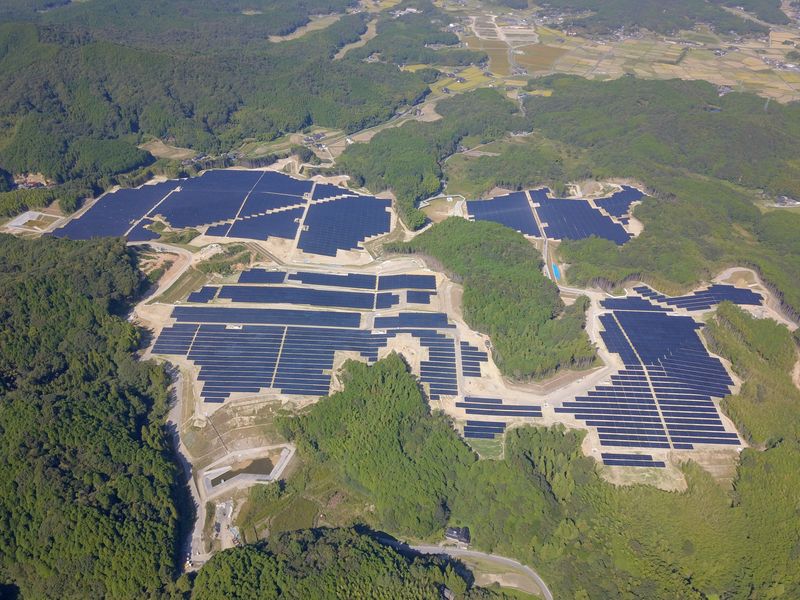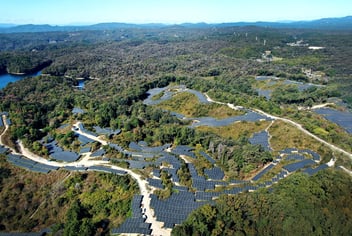Japan's Shift to a Feed-in-Premium Renewable Energy Market - Martin Stein, Head of Amp Japan


The world’s third-largest economy will soon transition its renewable sector from Feed-in-Tariff to a Feed-In-Premium. Amp Energy’s head of Japanese operations believes this market-based program will create a more level playing field in the country’s drive towards net-zero.
Japan has long been a trendsetter in the renewable space, as one of the first countries to manufacture photovoltaics and deploy large-scale PV installations. In 2012, Japan launched a Feed-in-Tariff (FiT) to stimulate renewable growth and reduce greenhouse gas emissions. Under this program, approved renewable generators receive a fixed payment for each kilowatt-hour produced over periods of up to 20 years.
In June 2021, the Japanese government announced it would begin the transition to a Feed-in-Premium (FiP) starting from early 2022. Combined with Japan’s recent net-zero pledge, the announcement of the FiP has the country poised for one of the world’s fastest and most comprehensive energy transitions.
Martin Stein is a veteran of the renewable energy industry and heads Amp’s Japanese operations. He has over 15 years of experience in M&A, leveraged finance, and energy project finance, and has held key roles with ING Finance in London and Shinsei Bank in Tokyo, where he has lived for the last ten years. “I moved into Japan’s energy finance sector as the original FiT really gained momentum, which was around 2013. One of the first projects I helped finance was a five-megawatt solar deal, which is small by today’s standards, but it felt like a real breakthrough at the time.”
Martin has been a member of Amp’s leadership for almost five years and now leads a team of 25 people developing, building, and operating renewable assets throughout Japan. “We’ve achieved a lot in that time, more than 300 megawatts of solar so far, and we’re extremely excited about the volume and variety of projects we have coming up in the pipeline.”
Accelerating Japan’s Net-Zero Ambitions
Japan was one of the earliest adopters of solar energy, initially through large-scale solar parks followed by rapid growth in its residential and commercial sectors. On the back of the country’s recent net-zero pledge, Japan’s renewable energy market is now gearing up for a decade of monumental growth.
“A few months ago, the Japanese government formally committed to carbon neutrality by 2050, and that was a really significant moment for the country,” Martin said. “More recently, it has also implemented a target of 36-38% renewables by 2030, which has now become the official national policy.”
The 2011 Fukushima nuclear disaster made headlines all over the world, and Martin says it was a critical tipping point in Japan’s pivot to renewables. “A lot of the current renewable momentum started with Fukushima, which really shifted public opinion and spurred people into action. The public view around nuclear in Japan is still quite negative, and clearly that’s a major driver in the renewable policy.”
Shortly after the Fukushima accident, Japan suspended all 54 of its nuclear plants, and only nine are in operation today. In a move indicative of the national shift to renewables, Amp Japan recently announced it had begun the construction of a 60MW solar park in Fukushima City.
“Japan is the 3rd largest electricity market in the world, so it’s almost hard to contemplate just how ambitious some of these renewable energy targets are.”
Martin says that while Japan’s renewable sector has made incredible progress over the last ten years, the newly mandated targets have put the country on an even more ambitious trajectory. “We’re currently at around 18% renewables, so to get to 38% means doubling solar and more than doubling wind,” he said. “It’s taken Japan almost 30 years to install 60 gigawatts of solar, and now we need to double that in just nine years. I don’t think you’ll see many other countries getting close to that in terms of new capacity.”
The Transition from FiT to FiP
When Japan launched its original FiT program in July 2012, its renewable generation capacity stood at around 20 gigawatts. The program has been an overwhelming success, and the national total has risen four-fold to more than 81 gigawatts, driven largely by solar PV. During this time, the government has gradually reduced FiT rates for new entrants due to falling renewable costs and mounting pressure to curb the program’s escalating budget.
Recently, the Japanese government announced it would begin the transition from a Feed-in-Tariff (FiT) to a Feed-in-Premium (FiP) starting in April 2022. The new program will allow renewable generators to sell electricity in the spot market at a premium to wholesale prices. The change is designed to increase competition in the renewable space while lightening the consumer cost burdens of the existing FiT program. “We’re seeing a massive demand for clean energy in Japan, particularly from corporate customers, and the FiP is a framework that will help us to meet more of that demand,” Martin said.
While some of the program’s details are still to be announced – including how the premium will be calculated - solar systems 1MW or larger will fall under the FiP program, while systems above 50kW but smaller than 1MW will have a choice between the FiT and FiP.
“Amp has a growing list of successful global corporate PPA partnerships, and we are working to replicate as many of these relationships as we can in Japan.”
“In some sense, the new FiP market will almost be a corporate PPA market, at least initially. And that’s because it will be a market transaction plus a premium, and that’s very likely to be a corporate PPA transaction,” Martin said. “It’s essentially a bridging phase between the FiT and what will eventually become a purely market-driven renewable energy sector. The FiP is intended to provide the transition support we need to get to that market parity, which is the ultimate goal.”
Japan’s C&I Renewable Energy Push
With net-zero and renewable energy targets now in place, Japan has a clearer vision of its carbon-neutral future. And in a similar fashion to countries such as Germany and the US, Japan’s C&I sector is taking a leading role in national decarbonization. Martin says that while consumer-facing companies have traditionally been the most proactive, the majority of organizations are now making green investments.
“There are two main segments in the Japanese C&I market. First, there are the smaller customers typically looking for physical PPA’s in which we provide clean energy directly to the facility. These are very interesting because we need to shape the energy we provide to the offtaker, and that’s where batteries can play a large role,” he said. “Secondly, we also engage with the large blue-chip companies looking for virtual PPA’s, which are effectively the delivery of green attributes, certificates, or products that allow them to embrace clean energy. At Amp Japan, we’re strongly focused on both.”
“Japan has 50 companies in the RE100, the second-largest share behind the USA. The space is big, and the demand for clean energy is huge.”
As key pieces of the global economy, many Japanese companies now face external pressures to raise their environmental credentials. “Japan is a very large manufacturing country and a big part of the global supply chain, so there's a big push coming from downstream customers to decarbonize,” he said. “Japanese companies have been very successful in making computer chips, electronics, vehicles, aviation equipment, and smartphone components. And if you supply Apple, for example, you now have to be carbon-neutral by 2030.”
Amp is one of the world’s five largest corporate PPA providers, according to a 2020 report by Bloomberg New Energy Finance. Amp is also a member of the Japan Climate Leaders Partnership, a coalition of approximately 200 companies supporting the RE100 and other organizations towards their renewable energy targets. “We’re very proud to be involved in this association, and we’re working with a number of partners to help them achieve their clean energy goals.”
The Unique Challenges of the Japanese Renewables
Decarbonizing a country of more than 120 million people is no easy task, particularly one with such a dense population and energy-intensive economy. Martin says the economics in Japan can be challenging due to the costs associated with land shortages and a frequent lack of interconnection capacity.
“For solar PV, particularly in the corporate PPA context where we need to achieve effective market prices, land is the biggest challenge. Flat land is hard to find, and so we often look for ex-industrial areas that were either intended for development or were previously used and can be repurposed.”
In September 2021, Martin’s team achieved commercial operation of its 7MW Kotagawa solar park on land that was initially developed for coal mining. “As part of the construction, our team has also improved discharge of water from the site, which was highly appreciated by residents and the local government.”
Martin also says financial institutions in Japan tend to be more conservative than others when it comes to FiP project bankability. “I think there’s a general expectation among the banks that the FiP will take one or two years to fully pick up, as we saw with the initial FiT,” he said. “We always aim to be a first-mover in the market, and we already own our first PPA’s in terms of closing acquisitions of non-FiT projects. With an official start date for the FiP now announced, we’re working on a pretty significant pipeline of new developments as we speak.”
Smarter Grids with Energy Storage and Amp X
Amp has been rapidly progressing in the energy storage space, deploying both standalone battery assets and hybridized solar and wind farms. Martin believes that while Japan has been slower to embrace energy storage than some leading economies, the market-driven FiP will create stronger incentives to store and deliver on-demand renewable energy.
“Traditionally, I think Japan has lagged behind the rest of the developed world as far as batteries go, and that’s partially because the FiT program did not really consider or reward batteries,” he said. “With the FiP coming in, batteries will be significant differentiators, particularly for physical PPA customers looking to shape their supply and meet their exact demand curves.”
“Batteries are critical to Japan’s energy transition, not only to store and dispatch renewable energy but provide valuable ancillary services that contribute to a cleaner electricity grid.”
“As more small-scale intermittent energy sources come online, managing the distributed energy system will be critical, which is where Amp X comes in.” Amp X is a new proprietary digital energy platform that can autonomously charge and dispatch battery assets based on real-time market signals. The platform can also serve as a life management tool that monitors system health, maximizes uptime, and ensures reliable long-term operation.
Amp X has also developed Smart Tx, a direct replacement for conventional power transformers that provides valuable grid services such as power factor optimization and autonomous voltage regulation. “There’s growing interest in the Smart Tx amongst the Japanese utilities, particularly with distributed renewables and energy storage set for such rapid growth,” Martin said. “We’re currently running Smart Tx pilot projects in the UK and Australia, and we’re now in discussions with Japanese grid operators as well.”
Martin believes that while energy storage has been slow to take hold in Japan, improving economics and the move to a FiP will accelerate its adoption. “I think as costs continue to fall, batteries will become a very large part of the picture. There are also some government incentives currently in discussion, so all of this points to energy storage being a key piece of Japan’s energy future”.
The Future Outlook for Japanese Renewables
Fueled by Amp’s progress and the shift to a market-based FiP program, Martin is excited to be a part of Japan’s journey to net-zero. “Without question, we’re going to see incredible growth in our renewable sector over the next decade. I also expect to see a pretty significant transformation of how the electricity market operates, in which a lot of additional grid capacity will be supplied by private parties.”
“In the future, I expect to see solar installed on virtually all buildings in Japan. That’s something both the public and the government are very serious about.”
On the back of Amp’s recently acquired wind portfolio in Spain, Martin and his team are also seeking to develop wind assets in the Japanese market. “We are currently working on a significant onshore wind pipeline, which is still subject to FiT auctions as wind is not necessarily a FiP market yet. As we continue building this development pipeline, we expect some of it will be FiT auction, and some of it will be through corporate PPA’s.”
Despite the scale of the work lying ahead, Martin is confident that Amp will play a critical role in decarbonizing the world’s third-largest economy. “Japan is a very exciting and dynamic market. To some extent, the roadmap to net-zero seems almost obvious, due to the incredible progress we’re seeing here and in our other key markets such as Australia, the US and Canada,” he said.
In the ever-changing renewable energy sector, Martin stresses the importance of capitalizing on new opportunities and making calculated, long-term investments. “Amp is a very fast and agile company, and we don’t just adapt to the needs of the market, we like to be the ones taking the lead,” he said. “Japan is one of our most important markets, and we’re very committed to the long-term success of our projects, our development partners, and our customers.”





